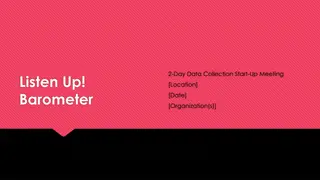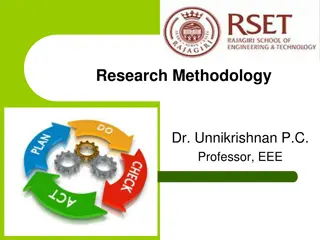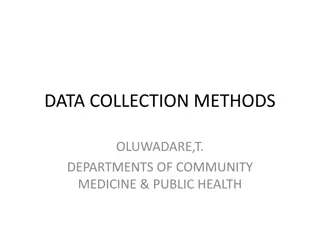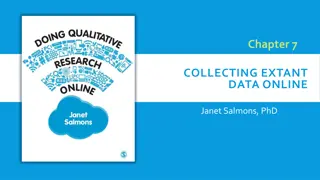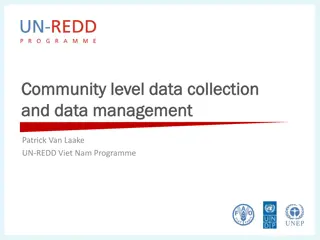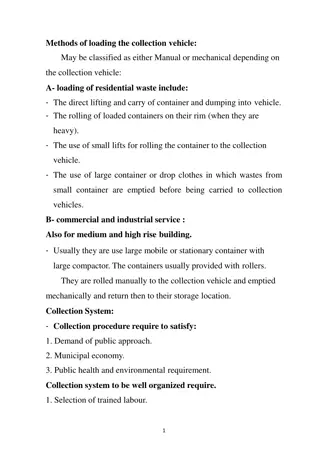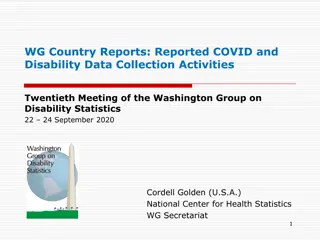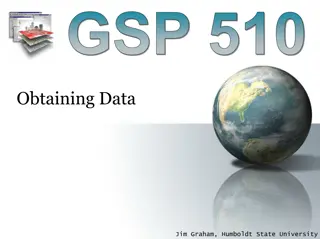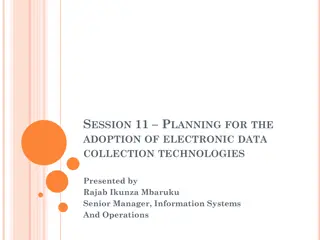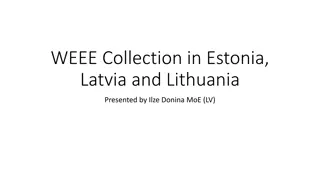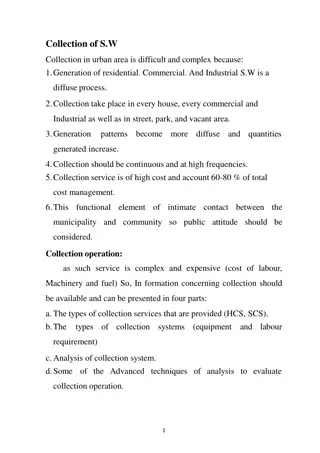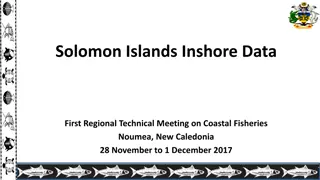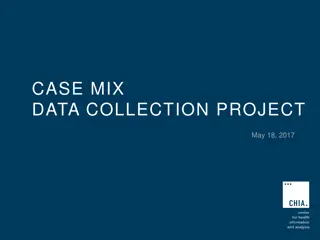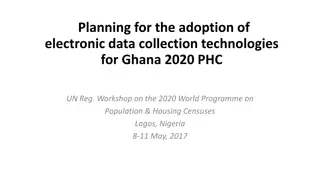Methods of Data Collection - An Overview
An ideal data collection procedure should be clear, unbiased, reliable, and valid. There are four main methods of data collection: Observation, Interview (Questionnaire), Use of Documentary Sources, and Others (FGDs, Life History, Case Studies, etc.). Each method has its advantages and disadvantages, impacting the accuracy and efficiency of information gathering in research and decision-making processes.
Download Presentation

Please find below an Image/Link to download the presentation.
The content on the website is provided AS IS for your information and personal use only. It may not be sold, licensed, or shared on other websites without obtaining consent from the author.If you encounter any issues during the download, it is possible that the publisher has removed the file from their server.
You are allowed to download the files provided on this website for personal or commercial use, subject to the condition that they are used lawfully. All files are the property of their respective owners.
The content on the website is provided AS IS for your information and personal use only. It may not be sold, licensed, or shared on other websites without obtaining consent from the author.
E N D
Presentation Transcript
Nonequilibrium Greens Function and Quantum Master Equation Approach to Transport Wang Jian-Sheng 1
Outline A quick introduction to nonequilibrium Green s function (NEGF), applied to molecular dynamics with quantum baths Formulation of quantum master equation to transport (energy, particle, or spin) Dyson expansion and 4-th order results 2
NEGF Our review: 1. Wang, Wang, and L , Eur. Phys. J. B 62, 381 (2008); 2. Wang, Agarwalla, Li, and Thingna, Front. Phys. (2013), DOI:10.1007/s11467-013-0340-x 3
Evolution Operator on Contour i 2 ( , ) = exp , U T H d 2 1 2 1 c 1 ( , ) ( , ) U = = ( , ), U U 3 2 2 ( , ) , 1 3 1 3 2 1 1 ( , ) U U 1 2 2 1 1 2 + + ( ) = ( , ) ( , ) U t O OU t 0 0 4
Contour-ordered Greens function i ( , ') = ( ) ( ') u T G T u C i ( ) H d = ( ) t T u u e T Tr C 0 ' C Contour order: the operators earlier on the contour are to the right. See, e.g., H. Haug & A.-P. Jauho or J. Rammer. t0 5
Relation to other Greens functions ( , ), t = = or , t ++ + G G G G ( , ') = ' ( , ') t t or G G G + ++ + = = = = t , G G G G + t , G G G G t0 6
Heisenberg Equation on Contour i 2 ( , ) = exp , U T H d 2 1 2 1 c 1 + + ( ) = ( , ) ( , ) U t O OU t 0 0 ( ) dO = [ ( ), O ] i H d 7
Thermal conduction at a junction Left Lead, TL Right Lead, TR semi-infinite Junction Part 8
Three regions 1 u u L L 2 = = = , , u u u u u C L L C u R i = = T ( , ) ' ( ) ( ) ' , , , , G T u u L C R C 9
Important result 1 ln( Tr 0 L G 1 = A ln ) Z 2 = + = + = A L x L , , G g g G 0 0 C C L R L ( = ) = + + A L ( , ) ' ( ), ' ( ) ' ( , ) ' x x L L + ( ) ( ) / 2 if 0 x x t t t M = + ( ) / 2 if 0 x t t t M 0 otherwise 10
Arbitrary time, transient result 1 ln 0 G Z = A L Tr ln( 1 ) 2 n ln i Z n = n Q ( ) = 0 A L ln i 1 Z = = = Tr Q Q G 0 ( ) 2 ( ) i = 0 2 ln i Z 2 = = 2 2 Q Q Q 2 ( ) ( in long time) Q t I M 11
Numerical results, 1D chain 1D chain with a single site as the center. k= 1eV/(u 2), k0=0.1k, TL=310K, TC=300K, TR=290K. Red line right lead; black, left lead. From Agarwalla, Li, and Wang, PRE 85, 051142, 2012. 12
Quantum heat-bath & MD Consider a junction system with left and right harmonic leads at equilibrium temperatures TL & TR, the Heisenberg equations of motion are = = = L LC , u K u V u u u L L C 1 C CL CR , u F V u V u C L R 2 R RC = u K u V u u R R C u The equations for leads can be solved, given j t = + 0 L LC ( ) ( ) ( ') ( ') ', u t u t g t t V u t dt L L C where 2 2 d dt d dt + = + = 0 L L L ( ) 0, ( ) ( ) t I K u t K g t L 2 2 13
Molecular dynamics with quantum bath t 2 ( ) d u t dt = + + C r ( ) t ( ') ( ') ' F t t u t dt C C L R 2 ( ') t + = = T ( ) t ( '), , , i t t L R = 2 V , , , , = = + r C r C r r L r R , g V See J.-S. Wang, et al, Phys. Rev. Lett. 99, 160601 (2007); Phys. Rev. B 80, 224302 (2009).
Equilibrium simulation 1D linear chain (red lines exact, open circles QMD) and nonlinear quartic onsite (crosses, QMD) of 128 atoms. From Eur. Phys. J. B, 62, 381 (2008). 15
From ballistic to diffusive transport 1D chain with quartic onsite nonlinearity ( 4 model). The numbers indicate the length of the chains. From JSW, PRL 99, 160601 (2007). Classical, 0 4 16 NEGF, N=4 & 32 64 256 1024 S L 4096 = = , J T 16
Conductance of graphene strips Sites 0 to 7 are fixed left lead and sites 28 to 35 are fixed right lead. Heat bath is applied to sites 8 to 15 at temperature TL and site 20 to 27 at TR. JSW, Ni, & Jiang, PRB 2009. 17
Quantum Master Equation Advantage of NEGF: any strength of system- bath coupling V; disadvantage: difficult to deal with nonlinear systems. QME: advantage - center can be any form of Hamiltonian, in particular, nonlinear systems; disadvantage: weak system-bath coupling, small system. Can we improve? 19
Dyson Expansions = , ) ( ) ( , t O t S t ( ) t Tr ( ) O S 0 H B ( ) V d i = = Tr ( ) , B c T O t e C 0 ( ) V d dO dt = + [ ( ), ( )] O t V t e ( ) t Tr ( ) , B c T O t C 0 H 2 4 = + + + 2 4 6 T T T ( ) X X V X V O 2! |, 4! Tr 0 0 0 .. = = | X n m B cT d 0 1 nm 0 20
Divergence 1 n 1 V V = 1 T n T n , X V X + i n d d is diagonal, d E E = = if | | m n X m n mn 21
Unique one-to-one map, 0 ordered cumulants = ; 2 4 4 + + 2 4 2 T T T X V X V X V ( ) 2! 0 2 2 T 2! 4! X V 4 d dt = + + 2 3 T T [ , ] V V [ , ] V V i X X 3! 4 E E + = T [ , ] V V X m n mn 2 T 2! X V 4 4 = + + 2 3 6 ( ) I VV VV VV H 2 T 3! 2! X V = T L LC V p V u C 22
Order-by-Order Solution to |1 1| 0 0 0 ... = = + + + (0) 2 (2) 4 ( ) O 0 0 ... |2 2| = X T T d T f X X X d 0 |3 3| = (0) f ... 0 1 i = (2) f T f [ , ] V V X 0 |1 2| |1 |2 3| 3| ... (0) |2 |3 1| 1| |3 0 = X ... f 2| 0 = T d [ , ] V V 0 X ... ... ... (0) d 1 3! = 3 T d T d T d [ , ] V V [ , ] V V [ , ] V V X X X (2) d (2) f (0) 1 2! + T d [ , ] V V X 2 T X V (0) 23
Diagrammatics Diagrams representing the terms for current `V or [X T,V]. Open circle has time t=0, solid dots have dummy times. Arrows indicate ordering and pointing from time - to 0. Note that (4) is cancelled by (c); (7) by (d). From Wang, Agarwalla, Li, and Thingna, Front. Phys. (2013), DOI: 10.1007/s11467-013- 0340-x. 24
QD model to 4th order The coefficients for the current IL= a2 +a4 2, for the Lorentz-Drude bath spectrum J( ) = /(1 + 2/D2). 50% chemical potential bias, equal temperature. Curves from NEGF, dots from 4-th order master equation. From Thingna, Zhou, and Wang, arxiv:1408.6996. = H E d d 0 S = + h.c. V g c d , , j j = , , j L R = H c c , , , j j j j 25
Spin-Boson Model The coefficients for the current IL= a2 +a4 2 For the spin-boson model with Rubin baths, J( ) = (1/2) (4- 2)1/2. TL = 1.5, TR=0.5, E=0.5. We see co- tunneling featuers. From Thingna, Zhou, and Wang, arxiv:1408.6996. E = + H S z x 2 2 = V g Q z , , j j 2 = , , j L R 1 2 ( ) = + 2 2 2 H P Q , , , j j j 26 j
Summary NEGF: powerful tool to study transport in nanostructures for steady state and transient Application to molecular dynamics quantum heat bath Quantum master equation approach arbitrary strong interaction in the system 27



